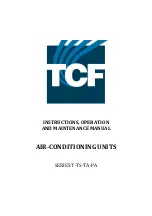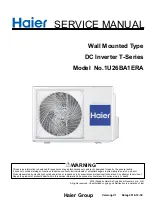
11
□
(4) Pipe connection and insulation
1)
Make sure the interceptor valve of the outdoor unit is completely shut.
2)
Connect the pipes between the indoor unit and the outdoor unit. When locking pipefittings,
coat refrigeration oil on the interior and exterior edges of the flare and lock the fitting with two
wrenches at the specified torque. Check leakage after locking. Fill pipes up with nitrogen
before welding.
3)
Fix the pipes between the indoor unit and outdoor unit appropriate. Avoid fixing pipes on
weak wall surface and ceilings. This may cause vibration and noise, particularly for short pipe
length.
4)
Re-confirm there is no leakage after piping.
5)
Wrap pipefittings with insulation sheets and pack with plastic tape for insulation. Also, wrap
the gas inlet and liquid inlet of the refrigerant pipe with insulation sheets to ensure insulation.
Remark: Prepare refrigeration oil
on-site.
Supplier: JX Nippon Oil & Energy
Corporation
Type: Synthetic Ze-GLES RB74
●
Interceptor valve on the outdoor unit
Model
RAM-112/125/140/160FPSQB
Gas Inlet
Liquid Inlet
Hex key (mm)
5
4
Spool locking torque (N•m)
11~14
7~9
●
Interceptor valve on the indoor unit
Work with two wrenches
.
Locking torque table:
Pipe size
Torque
Φ
6.35 (1/4 ”)
20 N•m
Φ
9.53 (3/8 ”)
40 N.m
Φ
12.7 (1/2 ”)
60 N.m
Φ
15.8 8 (5/8 ”)
80 N.m
□
(5) Air-tightness test
1)
Shut the interceptor valve spool of the gas and liquid inlets before running the air-tightness test.
2)
Fill in air or non-flammable gas (except for oxygen and toxic gases) from the pipe union of the fluid inlet and the pipe union of
the gas inlet to run the air-tightness test. The pressure is 4.15MPaG. Release gas after the test.
□
3-2 Evacuation and Refrigerant Filling
(1) Evacuation
1)
Please refer to the instructions on the attention plate inside the panel cover for details of interceptor valve operation.
2)
Evacuate from both the gas and liquid interceptor valves until pressure is below -0.1MPaG (-750mmHg).
3)
After evacuation, shut the valve on the manifold gauge set, stop evacuation, and settle for one hour to
see if meeting reading
rises.
4)
As the pipe union does not fit in the cap nut, use a filling hose. Also, lock the cap nut at 15-16N•m afterwards.
5)
Make sure to check leakage with a leakage detector and bubbles. Do not use bubble liquids containing NH
3
. Recommended
bubble liquids for the leakage test tabulated below. Do not use general household detergents in the bubble test.
(2) Refrigeration filling
1)
The unit has been equipped with refrigerant before shipping. If pipes are longer than the design range, add suitable amount of
refrigerant on-site (p. 12).
2)
Fully open the gas interceptor valve.
3)
The compressor operates when the air-conditioner is in operation. Add refrigerant from the pipe union of the fluid interceptor
valve. At the same time, the fluid interceptor valve opens slightly.
4)
Fully open the fluid interceptor valve after filling refrigerant.
5)
Make sure to check leakage afterwards.
※
Note
1.
When removing the cap of the interceptor valve spool, gas will pop from the O-ring inside and thread, which is irrelevant to a gas
leak.
2.
As the outdoor unit uses R401A refrigerant, use the manifold gauge set and filling hose for R401A refrigerant.
3.
When pressure does not drop below -0.1MPaG (-750mmHg) after evacuating for one hours, there may be leakage or water inside
the pipe. First, check if there is leakage. Next, evacuate for one hour again. Lastly, check pressure again
.
Do not purge air inside the unit with refrigerant. This will result in refrigerant insufficiency and cause machine damage.
Recommended bubble liquids
Bubble Liquid
Manufacturer
SNOOP NUPRO
(USA)
ギュポフレックス
Yokogawa & Co., Ltd.
(Japan).
Make sure to check refrigerant leakage. Mass refrigerant
leakage will cause:
1.
Oxygen insufficiency.
2.
Toxic gas production in contact with heat.
Guidelines for Refrigerant Pipe Installation
Gas piping
Manifold
gauge set
Vacuum pump
Nitrogen cylinder
(for welding and air-tightness test)
Gas valve
Liquid valve
Liquid piping
Indoor Unit
□
Make sure to add insulation to the pipe
union and cap nut.
□
Make sure to add insulation to fluid
pipes.
(To prevent performance from
deterioration due to external
temperature influence and pipe surface
condensation due to low pressure).
Interceptor valve control of the liquid inlet.
Interceptor valve control of the gas inlet.
Do not work with two
wrenches here to prevent
refrigerant leakage.
Interceptor
valve
Cap nut
Insulation Sheet Wrapping
Wrap the exterior with plastic tape
(both the gas and fluid pipes must be
wrapped with insulation sheets)
Содержание RAM-112FPSQB
Страница 20: ...20 66MP1388 RAC AF D ...






































